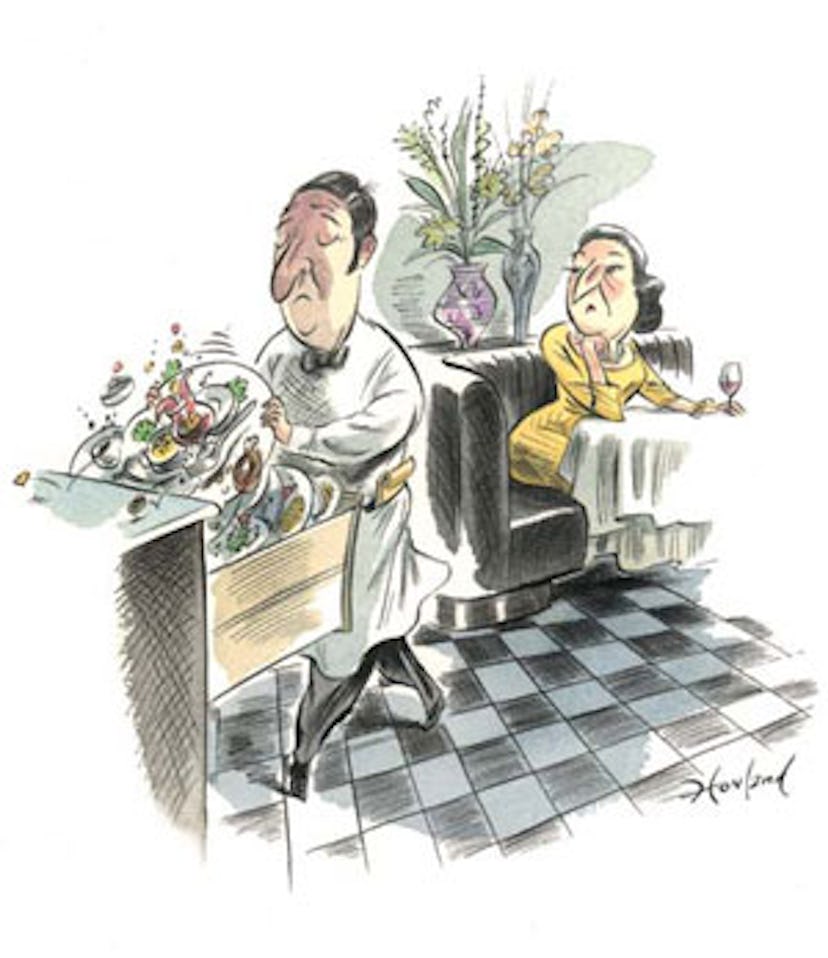Food for Thought
The Countess dines out and finds she has some reservations about New York’s restaurant landscape.

I’ve always wanted to be a food critic, so I’d like to talk about New York restaurants. Not the food, but what happens outside the kitchens (I wouldn’t dare go into some of those).
Speaking of kitchens, it never ceases to amaze me that the ex-Waspy Swifty’s has its kitchen right next to the unisex restroom. Still, that’s better than Harry Cipriani in the Sherry-Netherland, where one has to take a hike downstairs past the spa. The restrooms are so busy, they’re always a mess. Women have been known to grow tired of waiting and use the men’s room, and vice versa. Call it unisex extremis.
It’s not quite as bad at the London transplant Le Caprice in the nearby Pierre hotel, but almost. There the restrooms are in the hotel lobby and across from the mechanical room—I didn’t want to know what mechanics go on behind the door. Besides, I was too put out by their attitude. I’d phoned for a reservation, only to be turned down. So I called on one of the worst weather days of the year and got a table. I went with great anticipation into the black and white interior, which reminded me of an ocean liner circa 1925.
The day I went, the restaurant was relatively empty except for two young women beside me who continually chatted on their cell phones; two other, long-maned women who seemed to be more intent on keeping their hair in place than on the food; and a gray-clad Bernard-Henri Lévy and his friend, the white-clad Daphne Guinness, with an upswept, towering hairdo the likes of which I’d never seen before.
Le Caprice, as The New York Times’ new food critic, Sam Sifton, labeled it, was “fair.” But I was shocked to see that when the waitstaff cleared the tables, they shoved the half-empty plates into a drawer, closed it and left them there. Once the drawer was full, a busboy would arrive with a grayish-black plastic bin, and with panache plunk the dirty dishes into it and parade it out in front of the diners. How appetizing.
The restaurant scene in New York is so competitive that one never knows what’s in or what’s out. No one seems to talk about Le Cirque anymore. The gossip columns focus on Graydon Carter’s Monkey Bar, where everyone is more interested in the monkey business of who’s sitting where than the dull food.
Then there’s that place for the power elite, the Grill Room at the Four Seasons, which is filled mainly with aging men in dark suits. Why can’t they mix in a few interesting, attractive ladies (apart from me, that is) more often? Even Barbara Walters would do. Instead it’s tax lawyers, bankers, brokers and politicians.
Co-owner Julian Niccolini talks mainly about his olive oil, honey, wine and women; while his partner, Alex von Bidder, has written a charming children’s book, Wiggens Learns His Manners at the Four Seasons Restaurant, which is for their adult clients to give to their grandchildren, and for Lally Weymouth. The menu is back to its high-powered nursery-food best after the departure of buzzed-about Italian chef Fabio Trabocchi over “philosophical differences.”
To me, the most noteworthy things are the trendy silver wine units—$24,000 for the pair—at the front. They look like a Cadillac Escalade parked against the Philip Johnson paneling, and keep open bottles of wine fresh for up to two weeks.
But no column about restaurants would be complete without some discussion of food, which, like fashion, has its trends. Take the Washington-based Spanish chef José Andrés, who, according to BBC World News America, serves his dishes on sculptured hands rather than plates. Talk about finger food. I salute him.
And continuing with the topic of saluting, I’d like to start a club called Mirror, Mirror on the Wall—you can figure out why people qualify. Here is the first inductee:
• Terry Lundgren, chairman, chief executive and president of Macy’s, the glamour boy of retailing.
I’m sure you can come up with plenty more—as will I each month.